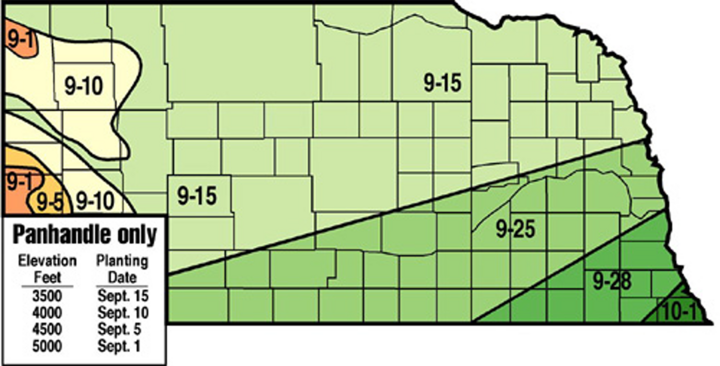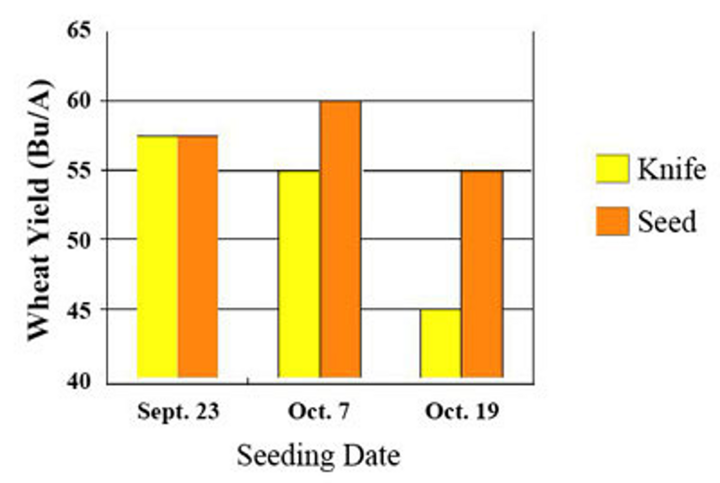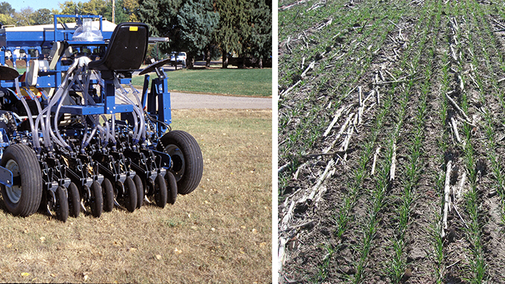In some years, you may not be able to seed winter wheat at the optimum time (Figure 1) for top yields due to weather, number of acres, equipment problems, or waiting until harvest of the previous crop. However, seed the fields or part of fields that are subject to wind erosion as soon as possible to the recommended seeding dates.
Winter wheat seeded late can result in higher winter wheat yields than winter wheat seeded earlier, especially when compared with winter wheat seeded much before the suggested dates (Table 1). This yield increase can be attributed to reduced disease and insect problems and the use of extra soil water and fertility used in the fall.

Here's an example regarding how diseases and early seeding with winter wheat may affect winter wheat yields:
A winter wheat variety test plot was next to a farmer’s winter wheat field with the farmer’s selected variety. The farmer seeded on Sept. 9 and the winter wheat field was lost because of the disease wheat streak mosaic, while the same winter wheat variety seeded only 10 days later in the variety test plot yielded well.
If you're going to be seeding wheat late, you can increase your chance of success by making these moves:
- Use narrow row spacings. For winter wheat, when seeding after the recommended date, narrow row spacings of five to eight inches are preferred over wider spacings of 10-15 inches. If you use a wider spacing, such as with a 15-inch seeder, consider seeding twice, with the second pass at a slight angle to the first. Use one-half the seeding rate each time. This will only work with disc drills; hoe drills move soil and would bury much of the seed from the first pass. Always seek to keep previous crop residues and roots anchored in fields to reduce biomass movement off fields into road ditches with strong wind events.
- Increase the seeding rate. For seeding rates when winter wheat is seeded during the recommended dates, see the Sept. 2, 2020 CropWatch article, “Determining the Seeding Rate for Winter Wheat”. Late seeding usually results in less root and tiller development. A general recommendation for dryland wheat is to increase the seeding rate 10-15 lbs. (150,000-225,000 seeds per acre for seed size of 15,000 seeds/lb.) for every week after the suggested seeding date for your area. The maximum seeding rate for dryland wheat is 120 lbs. (1,800,000 seeds per acre for seed size of 15,000 seeds/lb.). Another option would be to limit the seeding rate to no more than twice the seeding rate for the recommended date for your area.
For irrigated wheat, the recommended seeding rate is 90 lbs. (1,350,000 seeds per acre for seed size of 15,000 seeds/lb.) if seeded at the suggested seeding date. Increase the seeding rate 15-20 lbs. (225,000-300,000 seeds per acre for seed size of 15,000 seeds/lb.) for every week after the suggested seeding date to a maximum of 180 lbs. (2,700,000 seeds for seed size of 15,000 seeds/lb.) per acre.
Also, when no-tilling into dryland row crop stubble, seeding rates can be increased by as much as 50%, even when seeded during the suggested zone dates. When seeding occurs more than one week after the suggested seeding date, the rate should be 90-120 lbs. (1,350,000-1,800,000 seeds for seed size of 15,000 seeds/lb.) per acre for rainfed. With irrigated winter wheat, increase the seeding rate the same up to the maximum listed earlier. - Apply phosphorus with the seed. When seeding winter wheat late, phosphorus placed with the seed helps improve yield (Figure 2). Use 20 lbs. phosphorus where none is called for by soil tests and increase other phosphorus rates which are over 20 lbs. by 20% for late-seeded winter wheat.
| Seeding date | Yield (bu/ac) |
|---|---|
| Sept. 2 | 2 |
| Sept. 15 | 27 |
| Sept. 25 | 42 |

The normal superphosphates and ammonium phosphates generally have a negligible effect on winter wheat stands because of the low salt content of phosphorus fertilizers compared to nitrogen fertilizer, the low concentration associated with narrow rows (five to 12 inches), and the generally high rates of seed used. The seeding mechanism for applying phosphorus fertilizer with the seed is not critical unless the producer applies additional nitrogen at the same time. Do not apply over 15-20 lbs. of nitrogen per acre with the seed. Also, do not use 12-0-0-26.
If equipment is not available to place fertilizer in the seed furrow, 11-52-0 or 18-46-0 can be mixed with the winter wheat seed. A good mix is important, and fertilizer dealers can usually do this for you. I prefer to use 11-52-0 with its lower nitrogen content. With this method, check to see if you are satisfied with the mix by test drilling on top of the ground so you can observe how well the winter wheat seed and fertilizer are mixed. Be aware that with this method, the fertilizer may cause more wear to the drill. Also, fertilizers can absorb water, so take precautions against this.
- Use certified treated seed to increase seeding success. The seed treatments need to thoroughly coat the seeds to give good results and should be applied with quality seed-treating equipment.

